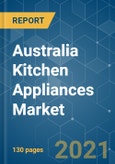The kitchen appliances market in Australia is significant and continues to grow. Factors like urbanization, a growing population, and an increasing focus on home cooking fuel the demand for modern and convenient kitchen appliances. Moreover, busy schedules and rapid changes in lifestyle are further fueling the demand for kitchen appliances, which make life more comfortable and easier. Additionally, innovations in technology and rising investments in research and development of various electric kitchen appliances are anticipated to drive the growth of the Australian kitchen appliances market during the forecast period. There is also rapid change in the way consumers shop for kitchen appliances. Residential building construction is forecast to increase over the period, supporting industry growth. In addition, household incomes are projected to rise over the next five years, with consumer sentiment remaining positive.
During the initial stage of COVID-19, the market experienced losses due to stoppages in manufacturing and distribution services caused by supply chain disruptions. Later, due to lockdowns and the work-from-home culture, the demand for kitchen appliances rose. Post-COVID, the market is experiencing gradual growth according to seasonal demand fluctuations.
Australian consumers prioritize convenience, energy efficiency, and aesthetics when it comes to kitchen appliances. Products that are easy to use, energy-efficient, and visually appealing perform well in the market. Energy-efficient appliances are highly sought after in Australia due to rising energy costs and a growing awareness of environmental concerns. Appliances with high energy efficiency ratings are popular among consumers. Health-conscious consumers are driving the demand for appliances that support healthy cooking and eating habits. Products like air fryers, steam ovens, and blenders for making smoothies are popular. Kitchen appliances are sold through various retail channels, including brick-and-mortar stores, department stores, specialty appliance retailers, and online platforms. Online sales gained traction, particularly for small appliances.
Australia Kitchen Appliances Market Trends
Small Kitchen Appliances, Coffee Machines, Microwave Ovens are High on Demand
Australians are leading busier lives. The convenience of small kitchen appliances such as microwave ovens and coffee machines became essential in their daily routines. These appliances save time and make meal preparation more efficient. Australia holds a strong coffee culture, with a preference for specialty coffee. The demand for coffee machines, especially espresso machines, reflects the desire for café-quality coffee at home. Australia includes a significant urban population. In urban areas, kitchen space can be limited, and small kitchen appliances are ideal for maximizing functionality in smaller kitchens. Many consumers in Australia are environmentally conscious and seek energy-efficient appliances. Manufacturers are responding by producing eco-friendly and energy-efficient small kitchen appliances.Refrigerator Occupies Highest Ownership Rate in Kitchen Appliance Market
Refrigerators are considered essential kitchen appliances, and nearly every household in Australia owns one. They are indispensable for food storage and preservation, ensuring that perishable items remain fresh and safe to consume. Refrigerators are built to last, and many consumers use the same refrigerator for a decade or longer. Their durability and long lifespan make them a valuable investment. Australian consumers appreciate the technological advancements in refrigerators, such as energy-saving modes, smart connectivity, and features like ice and water dispensers. These features enhance the usability and appeal of the appliance. The trend of cooking and eating at home, particularly during the COVID-19 pandemic, led to increased reliance on kitchen appliances, including refrigerators, to store ingredients and prepared meals. Some refrigerators come with innovative features like multiple cooling zones, adjustable shelving, and specialized compartments for different types of food. These features add to the appliance's functionality.Australia Kitchen Appliances Industry Overview
The Australian Kitchen Appliances industry is fragmented, with many players operating in the market. Many international players hold a presence in the kitchen appliance market in Australia. Australia includes some local manufacturers and brands that cater to the domestic market. These brands often focus on producing high-quality products and can be competitive in terms of price and local support. Price is a significant factor in consumers' decisions. Brands that offer competitive pricing, financing options, or promotions can attract price-conscious shoppers. Major players include Samsung Electronics, Electrolux, LG Electronics, Haier Group, Miele, Breville Group, Smeg, Artusi Appliances, ILVE, and Westinghouse. Samsung is the market leader in the kitchen appliance industry in Australia.Additional Benefits:
- The market estimate (ME) sheet in Excel format
- 3 months of analyst support
This product will be delivered within 2 business days.
Table of Contents
Companies Mentioned (Partial List)
A selection of companies mentioned in this report includes, but is not limited to:
- Samsung Electronics
- LG Electronics
- Breville Group
- ILVE
- Westinghouse
- Haier Group
- Electrolux
- Miele
- Artusi Appliances
- Smeg








